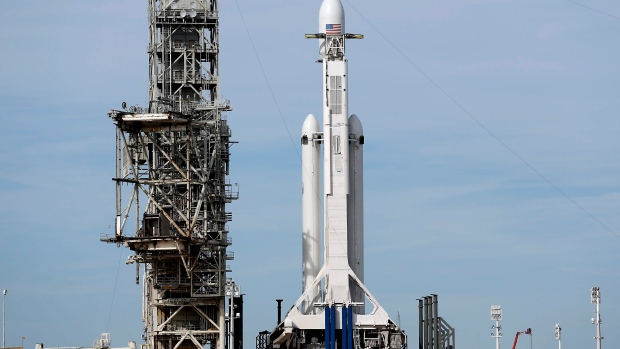Apr 10, 2019
SpaceX readies first Falcon Heavy launch for paying customer
, Bloomberg News

Elon Musk’s SpaceX is preparing to launch Falcon Heavy—its massive, heavy-lift rocket—for the first paying customer on Wednesday, more than a year after a demonstration mission in February 2018.Last year’s initial Falcon Heavy launch became a spectacle thanks in part to its test payload consisting of Musk’s cherry-red Tesla Roadster with a mannequin passenger, dubbed Starman, sitting in the driver’s seat. This time SpaceX will be carrying a payload for Saudi Arabia’s Arabsat, a satellite services provider. The Arabsat satellite will deploy roughly 34 minutes after launch.
If the weather holds and there are no technical issues, Falcon Heavy will rumble aloft at 6:35 p.m. Florida time on Wednesday from NASA’s Kennedy Space Center. Scores of fans and tourists have flocked to the Florida Space Coast for the event, which will be broadcast live on the SpaceX website. The Falcon Heavy has three boosters with 27 Merlin liquid-propellant engines in total, giving it more than 5 million pounds of thrust—the most for a launch since the Saturn V rocket last used for Apollo moon missions in early 1970s.
For SpaceX, the introduction of the large and reusable Falcon Heavy into its launch business gives the company the ability to bid on heavier payloads than it can with the smaller Falcon 9 rocket, opening up the market for big commercial satellites launches and national security missions. A standard Falcon Heavy launch costs US$90 million, according to the company’s website, compared to US$62 million for the Falcon 9.
SpaceX has several paying customers committed to flying on Falcon Heavy, including Inmarsat, Viastat and Arabsat, according to its launch manifest. The U.S. Air Force also chose Falcon Heavy for its STP-2, or Space Test Program 2 mission.
Following Wednesday’s launch, SpaceX will attempt to simultaneously return the two side boosters to landing pads and land the center core on a drone ship. Last year, SpaceX recovered two Falcon Heavy boosters on land but narrowly missed landing the third on a drone ship in the Atlantic Ocean.
SpaceX, based in Hawthorne, California, set a company record last year with 21 launches for customers. This year the big focus is on human flight: SpaceX has a contract with NASA to send U.S. astronauts to the International Space Station as part of what’s known as the Commercial Crew program.
In early March, SpaceX pulled off a key test by sending an unmanned Crew Dragon spacecraft to the ISS, then recovering it after a flawless splashdown. Proving that SpaceX can safely fly humans is key to Musk’s ambitions for space tourism and creating a human colony on Mars.





